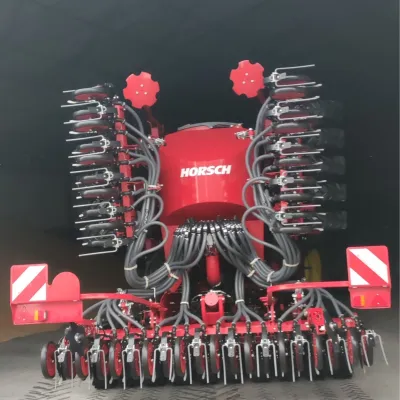General information
RDP Priority
- P2. Competitiveness
RDP Focus Area
- 2A: Farm’s performance, restructuring & modernisation
RDP Measure
- M04: Investments in physical assets
Beneficiary type
- Farmer / land manager
Summary
Andrzej Janczuk and his son, Adrian, manage a 200-hectare farm that is divided into multiple parcels across two voivodeships, three poviats and four communes. This fragmentation complicates logistics and increases operational costs. With a view to optimising efficiency and reducing expenses, they used CAP funds to purchase a modern seeder capable of simultaneously sowing seeds and applying fertiliser, with precise dosage, near the grain. The investment also included an IT system that collects and analyses data during sowing, enabling the farmers to make informed choices that enhance operational efficiency.
Results
- The project was a success. Sowing efficiency has increased to approximately 4–5 hectares per hour, enabling multi-seed planting, improving work efficiency and boosting production profitability.
- The acquisition of a machine with integrated software for data collection, recording and management reduces labour and minimises paperwork for the farmers.

Promoter
Andrzej Janczuk
Funding
Total project budget: 430 000 (PLN)
RDP support: 200 000 (PLN)
Private/own: 230 000 (EUR)
Context
Andrzej Janczuk’s farm is located near the village of Pilichowo in the Pomeranian Voivodeship. Andrzej runs the farm with the support of his son Adrian, who is studying agriculture and beginning his own business activities as a young farmer.
The farm spans over 200 hectares, divided into multiple parcels that are spread across two voivodeships, three poviats and four communes. This fragmentation, along with the distances between fields, complicates logistics and increases operational costs.
Primarily focused on cereal cultivation, the farm follows a crop rotation system and utilises a no-till approach. This method loosens and mixes the topsoil without turning it over, thereby preserving biological and microbiological activity, which aids in the decomposition of both mineral and organic substances.
To optimise efficiency and reduce costs, the farm needed to invest in modern equipment and new technologies. The most urgent requirement was a modern seeder capable of simultaneous seed and fertiliser sowing, ensuring precise dosage near the grain. This seeder could also be used for sowing catch crops. Given the fact that 'ISOBUS' technology was already in use in the farm’s existing equipment, Andrzej decided that the new machine should be similarly equipped, enabling seamless interoperability between the seeder, tractors, and other agricultural machinery. ISOBUS enhances data management, allowing operators to track fuel consumption, speed, and workload metrics.
Objectives
The main aim of the project was to optimise the farm’s sowing efficiency and thus improve its competitiveness.
Activities
The project involved selecting and purchasing agricultural machinery, training operators in its use and configuring software for data collection and analysis. The key activities included:
- Purchasing a modern seeder capable of simultaneously sowing seeds and spreading fertiliser with precise dosage near the grain. The machine is equipped with two chambers for sowing catch crops.
- Providing operator training, as specialised knowledge and skills are required to handle the advanced machinery.
- Implementing an ISOBUS IT system for electronic documentation related to sowing and fertilisation (fuel consumption, speed, workload metrics, etc.)
- Launching and testing the equipment on-site.
Main results
- The new equipment enables variable and precise sowing and fertiliser dosage, including the sowing of catch crops.
- Sowing efficiency has increased to approximately 4-5 hectares per hour of work. The farmers are able to sow different seeds and are satisfied that production profits have increased.
- Work efficiency has increased by approximately 40% compared to the previous seeder.
- Better yields have been achieved through precise fertiliser dosage at the grain, leading to fewer weeds and improved crop health.
- The seeder’s two-chamber design enables the sowing of two crops simultaneously, such as peas with undersown seed grass.
- Integrated software within the machinery facilitates data collection, processing and documentation maintenance. This reduces labour intensity and minimises paperwork by enabling the seamless transfer of data to various programs and applications.
- The overall impact of the project is a reduction in labour costs combined with enhanced production profitability.
Key lessons
- CAP funds play a crucial role in farm modernisation. The adoption of modern agricultural technologies, such as sowing with fertilisation, not only saves time and improves the yield, but also lowers the unit cost of production, leading to higher profitability.
- Farm development programs should prioritise the implementation of advanced agricultural techniques, including Agriculture 4.0 and even 5.0. The integration of new technologies, along with digital hardware and software solutions, enhances efficiency, optimises production management and streamlines farm operations.
- Expectations for the project were very high, and there was always a risk in decision-making, especially when introducing new technologies. Additionally, such investments are costly, requiring careful consideration and thorough preparation.
Although agriculture has been based on the same thing for centuries, farmers must introduce new forms of work to increase the profitability of production - in my case, precise sowing together with fertilisation pays off!
Adrian Janczuk

